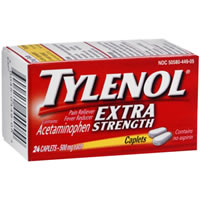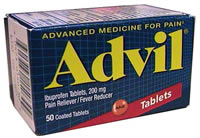Difference between Tylenol and Advil
Key difference: Tylenol’s active ingredient is acetaminophen, also know as paracetamol. Advil’s active ingredient is ibuprofen.
 Tylenol and Advil are medications most commonly used for pain and fever relief. They are both available over the counter. However, there have different chemical structures and different side effects.
Tylenol and Advil are medications most commonly used for pain and fever relief. They are both available over the counter. However, there have different chemical structures and different side effects.
Tylenol’s active ingredient is acetaminophen, also know as paracetamol. Whereas, Advil’s active ingredient is ibuprofen. Tylenol is best used for pain relief and fever reduction, and is commonly used long-term for osteoarthritis, chronic back pain and headaches. It has very few side effects, but in large doses can cause liver damage.

Advil, on the hand, is a nonsteroidal anti-inflammatory drug effective for pain relief, fever reduction, dental pain, and menstrual cramps. Its side effects include stomach bleeding or ulcers, increased blood pressure, fluid retention and reduced kidney function in long term use.
A complete comparison between Tylenol and Advil is as follows:
|
|
Tylenol |
Advil |
|
Generic Name |
Acetaminophen (Paracetamol) |
Ibuprofen |
|
Owned by |
McNeil Consumer Healthcare, a subsidiary of Johnson & Johnson. |
Pfizer |
|
Availability |
Over the counter |
Over the counter |
|
Effective for |
Reducing pain, reducing fever, relieving the symptoms of allergies, cold, cough, and flu. |
Headaches, toothaches, menstrual pain, minor aches, arthritis pain, fever, muscles, joints and backaches. |
|
Dosage |
Adults and children older than 12 - 1-2 tablets every 4 hours as needed. Should not exceed 8 tablets in 24 hours. Should not be taken with alcohol. |
Adults and children older than 12 - 1 or 2 tablets every 4 hours as needed. Should not exceed 6 tablets in 24 hours. Children under 12 should take children’s Advil. Should be taken with food.
|
|
Effects |
Lowers fever and reduces aches and pains. Does not reduce inflammation. Works on nerve cells. Safer for children. |
Limits the production of fatty acid known as prostaglandins. Reduces body aches pains, inflammation or swelling and redness. |
|
Ill Effects / Side Effects |
Fewer side effects. Large doses can cause stomach bleeding, renal failure, kidney or liver damage. Side effects may be more likely in chronic alcoholics or patients with liver damage. Chronic users may have a higher risk of developing blood cancer. |
Can irritate the stomach in toddlers. Constipation, diarrhea, dizziness, gas, headache, heartburn, nausea, stomach pain or upset stomach. In rare cases, esophageal ulceration, heart failure, hyperkalemia, renal impairment, confusion, and bronchospasm. Can aggravate asthma. |
Image Courtesy: medicineeffects.net, ilovetogossip.com









Add new comment